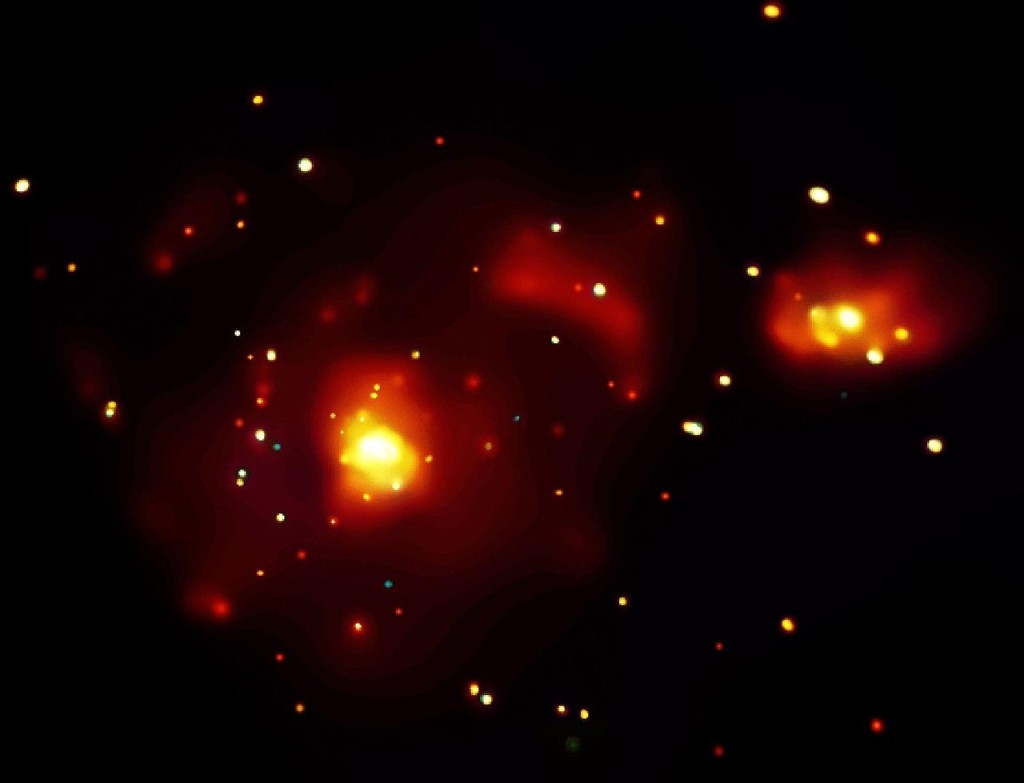Messier 51 (M51), better known as the Whirlpool Galaxy, is a famous grand-design spiral galaxy located in the constellation Canes Venatici. The Whirlpool Galaxy has an apparent magnitude of 8.4 and lies at an approximate distance of 23 million light years from Earth. It has the designation NGC 5194 in the New General Catalogue.
Messier 51 is one of the easiest Messier objects to find, as it lies in the vicinity of the Big Dipper asterism. The galaxy is positioned only 3.5 degrees southwest of Alkaid, Eta Ursae Majoris, the star that marks the end of the Dipper’s handle, or the tip of the Great Bear‘s tail.
An imaginary line drawn from Alkaid in the direction of Cor Caroli, the brightest star in Canes Venatici, leads directly to M51.
In good conditions, the Whirlpool Galaxy can be seen in binoculars. It is quite bright and appears face-on, which makes it a popular target among amateur astronomers and astrophotographers. M51 is also the brightest example of an interacting spiral galaxy in the sky.
Messier 51 appears as a patch of light in 10×50 binoculars, while small telescopes show a more diffuse patch of light with a bright central region. The galaxy’s bright core appears more defined in 8-inch instruments, which also reveal the galaxy’s large halo and a hint of the dark dust lanes and spiral arms. M51’s smaller companion galaxy, NGC 5195, is also visible, but the bridge connecting the two can only be detected in larger instruments.
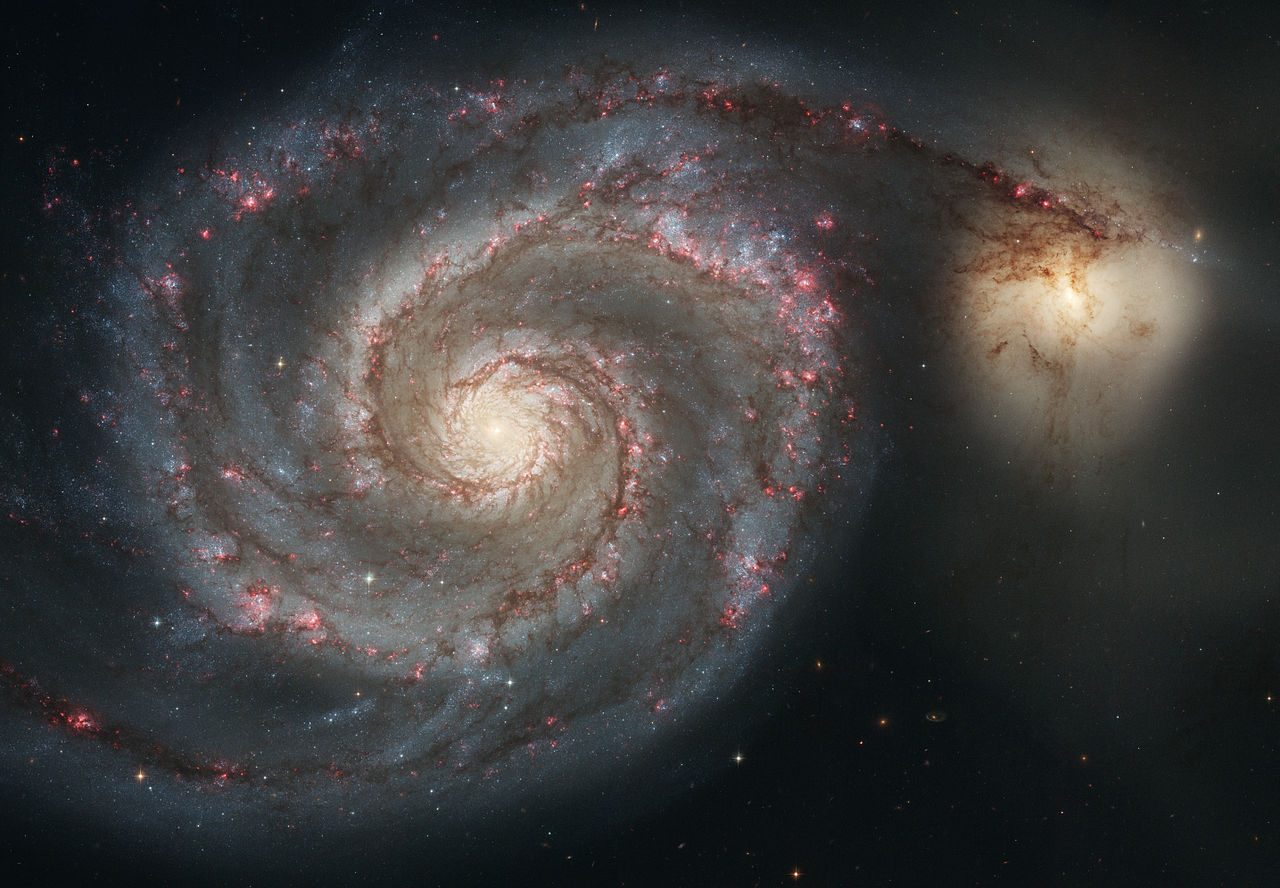
12-inch and larger telescopes reveal a number of spiral bands and vast H II regions, as well as the band of light that connects the Whirlpool Galaxy to its smaller neighbour. The best time of year to observe M51 is in the months of March, April and May.
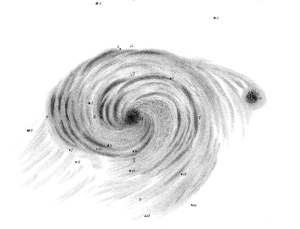
The Whirlpool Galaxy is also known as the Question Mark Galaxy or Rosse’s Galaxy, after William Parsons, 3rd Earl of Rosse, who was the first to recognize the spiral nature of this “nebula” in 1845.
Lord Rosse used his 72-inch reflector at Birr Castle in Ireland to observe M51 when he made the discovery. He also made a very accurate painting of the “spiral nebula” and, for this reason, the galaxy is sometimes known as Lord Rosse’s Question Mark.
It wasn’t until the 1920s, when Edwin Hubble proved that “spiral nebulae” were in fact distant galaxies, that Whirlpool and other objects of this type were recognized as independent galaxies and not nebulae inside the Milky Way.
The Whirlpool Galaxy is the brightest member of the M51 Group, a relatively small group of galaxies that also includes the famous Sunflower Galaxy (M63) and the fainter edge-on spirals NGC 5023 and NGC 5229.
Messier 51 is classified as a Seyfert 2 galaxy, an active galaxy with a quasar-like nucleus, a very high surface brightness and a characteristic bright core, one that appears particularly bright at infrared wavelengths.
The Whirlpool Galaxy is interacting with a smaller companion, NGC 5195 (Messier 51b), a dwarf galaxy connected to its larger neighbour by a tidal bridge of dust. The bridge is visible in images of the pair silhouetted against the central region of the smaller galaxy.
The tidal interaction with NGC 5195, which was not discovered until the advent of radio astronomy, has considerably enhanced the spiral structure of the Whirlpool Galaxy. Astronomers believe that it is also triggering waves of new star formation. The interaction leads to compression of hydrogen gas which, in turn, leads to formation of stellar nurseries. The two galaxies will eventually merge, but it will take another few passes for the merger to be complete.
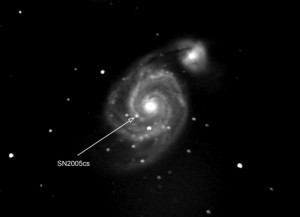
Three supernovae have been observed in M51 to date: SN 1994I (type Ic) in April 1994, SN 2005cs (type II) in June 2005, and SN 2011dh on May 31, 2011.
The last of these was a magnitude 14.2 type II supernova and it helped astronomers estimate the distance to the galaxy at 23 million light years.
A supernova was also observed in NGC 5195 on April 8, 1945. Designated SN 1945A, it reached 14th magnitude.
The supernova events also helped scientists estimate the Whirlpool Galaxy’s angular diameter at 11.2 arc minutes and the spatial radius of its bright circular disk at roughly 43,000 light years.
Messier 51 is about 35 percent the size of our own galaxy, the Milky Way, and has an estimated mass of 160 billion solar masses.
Cross
The Whirlpool Galaxy is believed to contain a central black hole surrounded by a ring of dust. Another ring crosses the first one on a different axis, giving the appearance of a cross at the galaxy’s nucleus.
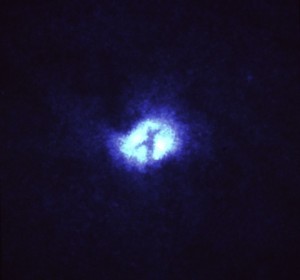
The dark X marks the exact location of the galaxy’s central black hole. The central region is currently showing evidence of increased star formation, which will not last more than another 100 million years at the current rate.
The Whirlpool Galaxy’s companion, NGC 5195, is believed to have passed through M51’s main disk some 500 to 600 million years ago, which resulted in the larger galaxy developing a highly pronounced spiral structure.
The smaller galaxy likely came from behind, passed through the larger galaxy’s disk and then crossed the disk again about 50 to 100 million years ago. Now, NGC 5195 appears to be slightly behind the Whirlpool Galaxy from our point of view.
Messier 51 contains a considerable number of X-ray sources, which are mostly X-ray binaries, systems consisting of two objects – a neutron star or a black hole and an orbiting companion star – with the first object capturing material from the companion.
The stolen material is accelerated by the strong gravitational field of the compact star or black hole and heated to extremely high temperatures, producing a highly luminous X-ray source.
At least 10 of the X-ray binaries discovered in M51 are bright enough to contain black holes and most of these black holes are likely stealing material from stars that are considerably more massive than the Sun.
A survey of the Whirlpool Galaxy revealed close to 500 X-ray sources. About 400 of these are believed to be within the galaxy, while the others are either in front of M51 or behind it.
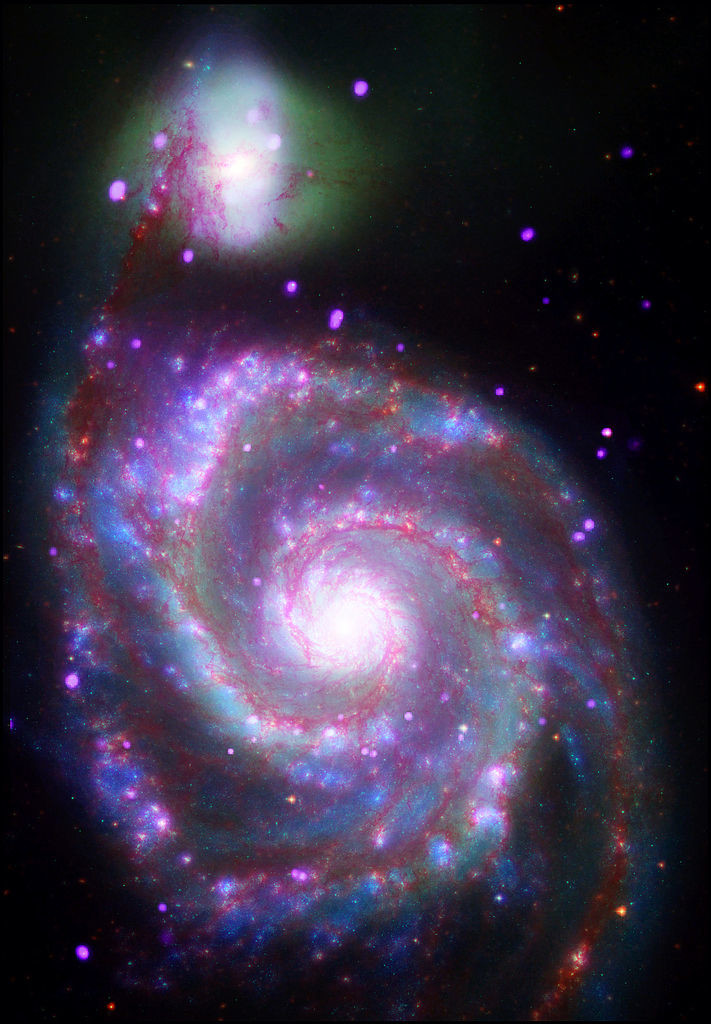
The Whirlpool Galaxy is one of Charles Messier’s original discoveries. Messier first observed the object on October 13, 1773. In January 1774, he offered the following description:
Very faint nebula, without stars, near the eye of the Northern Greyhound [hunting dog], below the star Eta of 2nd magnitude of the tail of Ursa Major: M. Messier discovered this nebula on October 13, 1773, while he was watching the comet visible at that time. One cannot see this nebula without difficulties with an ordinary telescope of 3.5 foot [FL]: Near it is a star of 8th magnitude. M. Messier reported its position on the Chart of the Comet observed in 1773 & 1774. Memoirs of the Academy 1774, plate III. It is double, each has a bright center, which are separated 4’35”. The two “atmospheres” touch each other, the one is even fainter than the other. Reobserved several times.
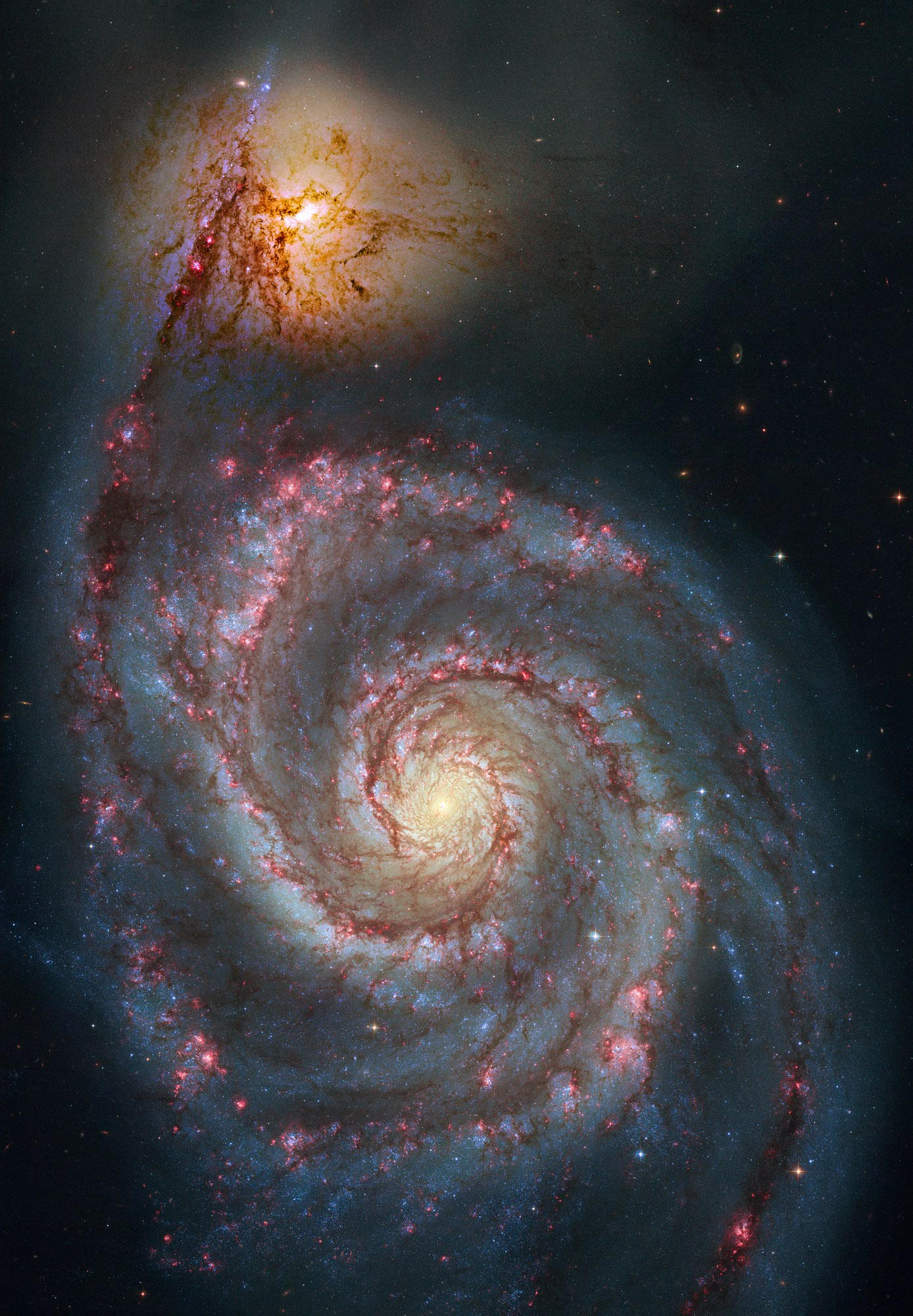
NGC 5195 was discovered by Messier’s friend and colleague Pierre Méchain on March 20, 1781. In his catalogue of 1781, Messier did not make it entirely clear if the object that he was referring to as M51 was just the larger galaxy or the interacting pair. As a result, the Whirlpool Galaxy (NGC 5194) is sometimes referred to as Messier 51a and the smaller NGC 5195 as Messier 51b.
William Herschel catalogued the object as H I.186 on May 12, 1787, with the following note: “Considerably bright. Pretty Large. Round or little elongated. Very gradually brighter toward the middle. 3′ north preceding [NW] of the 51st of the Connoissance des Temps [M51].”
John Herschel catalogued M51 as h 1622 in April 1830, noting a “very bright round nucleus surrounded at a distance by a nebulous ring.” He later added the object to the General Catalogue as GC 3574.
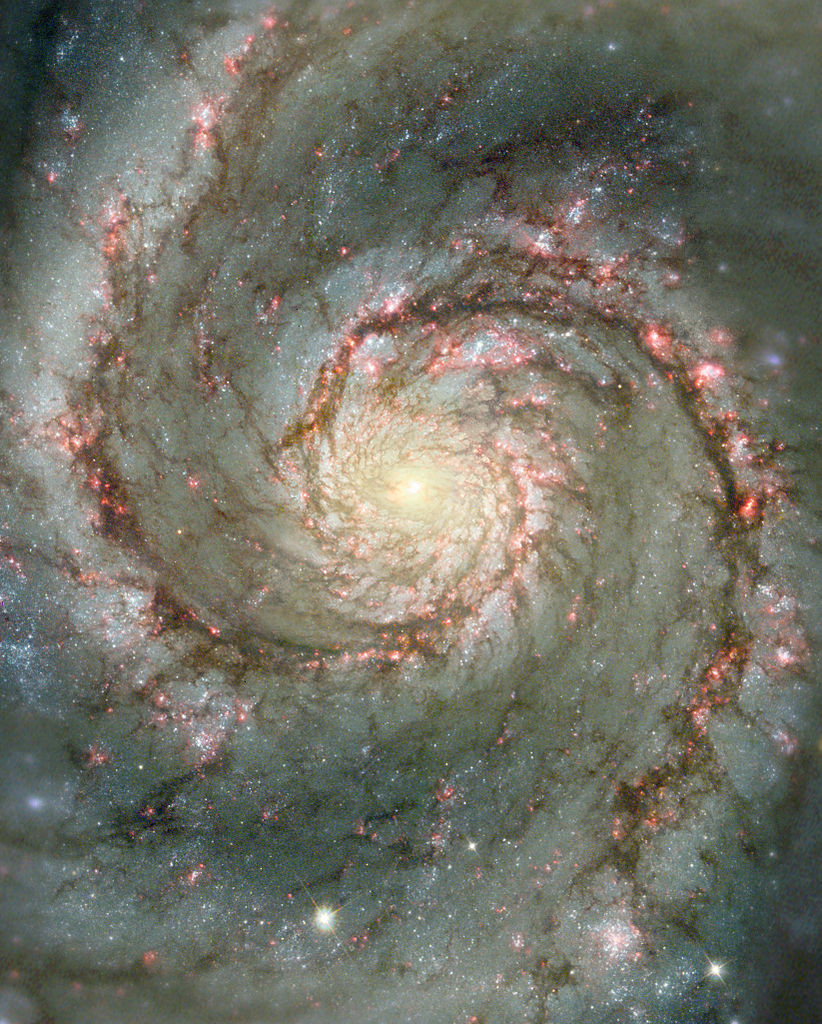
The Whirlpool Galaxy, also known as M51 or NGC 5194, is having a close encounter with a nearby companion galaxy, NGC 5195, just off the upper edge of this image. The companion’s gravitational pull is triggering star formation in the main galaxy, as seen in brilliant detail by numerous, luminous clusters of young and energetic stars. The bright clusters are highlighted in red by their associated emission from glowing hydrogen gas.
This Wide Field Planetary Camera 2 image enables researchers to clearly define the structure of both the cold dust clouds and the hot hydrogen and link individual clusters to their parent dust clouds.
Intricate structure is also seen for the first time in the dust clouds. Along the spiral arms, dust “spurs” are seen branching out almost perpendicular to the main spiral arms. The regularity and large number of these features suggests to astronomers that previous models of “two-arm” spiral galaxies may need to be revisited. The new images also reveal a dust disk in the nucleus, which may provide fuel for a nuclear black hole. Image: NASA and The Hubble Heritage Team (STScI/AURA)
Admiral William Henry Smyth observed M51 in September 1836 and offered the following description:
A pair of lucid white nebulae, each with an apparent nucleus, with their nebulosities running into each other, as if under the influence of a condensing power. They are near the ear of Asterion, the northern hound; and the smaller nebula, or northern one, having the brightest nucleus, was differentiated by the wire micrometer; they are 3deg southwest of Alkaid, where the place is indicated by a line from Dubhe through Megrez, extended nearly twice that distance into the southeast beyond. There are three telescopic stars following, and a bright 7th-magnitude about as far beyond them as they are from the nebulae, but the preceding part of the field is quite clear. Sir John Herschel has given a beautiful representation of this extraordinary object, [fig.] No. 25, in the illustrations to his Catalogue of 1830.
This fine field was discovered by Messier in 1772 [actually 1773], and described as a faint double nebula whose centres are 4’35” apart, but with “the borders in contact.” The southern object is truely singular, having a bright centre surrounded with luminosity, resembling a ghost of Saturn, with his ring in vertical position. They form Nos. 1622 and 1623 of [J.] H.’s catalogue, who terms the southern, or halo nebula, a most astonishing object, probably a similar system to our own, the halo representing the Galaxy. “Supposing it,” he remarks, “to consist of stars, the appearance it would present to a spectator placed on a planet attendant on one of them, excentrically situated toward the np quarter of the central mass, would be exactly similar to that of our Milky Way, traversing, in a manner precisely analogous, the firmament of large stars, into which the central cluster would have been projected, and (owing to its greater distance) appearing, like it, to consist of stars much smaller than those in other parts of the heavens. Can it then be that we have here a brother-system, bearing a real physical resemblance and strong analogy of structure to our own?”
We have then an object presenting an amazing display of the uncontrollable energies of the OMNIPOTENCE, the contemplation of which compels reason and admiration to yield to awe. On the outermost verge of telescopic reach we perceive a stellar universe similar to that to which we belong, whose vast amplitudes no doubt are peopled with countless numbers of percipient beings; for those beautiful orbs cannot be considered as mere masses of inert matter. And it is interesting to know that, if there be intelligent existence, an astronomer gazing at our distant universe, will see it, with a good telescope, precisely under the lateral aspect which theirs presents to us. But after all what do we see? Both that wonderful universe, our own, and all which optical assistance has revealed to us, may be only the outliers of a cluster immensely more numerous. The millions of suns we perceive cannot comprise the Creator’s Universe. There are no bounds to infinitude; and the boldest views of the elder Herschel only placed us as commanding a ken whose radius is some 35,000 times longer than the distance of Sirius from us. Well might the dying Laplace explain: “That which we know is little; that which we know not is immense.”
Halton Arp has included the Whirlpool Galaxy as No. 85 in his Catalogue of Peculiar Galaxies, listing it as a “Spiral with Large High-Surface-Brightness Companion.”
FACTS
| Object: Galaxy |
| Type: Spiral |
| Class: SA(s)bc pec |
| Designations: Messier 51, M51, M51a, NGC 5194, Whirlpool Galaxy, Rosse’s Galaxy, Question Mark Galaxy, PGC 47404, UGC 8493, Arp 85, GC 3572, VV 001a, VV 403, BD+47 2063, IRAS 13277+4727, 1RXS J132953.8+471143, TC 827 |
| Features: Interacting with smaller galaxy NGC 5195 |
| Constellation: Canes Venatici |
| Right ascension: 13h 29m 52.7s |
| Declination: +47°11’43” |
| Distance: 23 million light years (7.1 megaparsecs) |
| Number of stars: > 100 billion |
| Apparent magnitude: +8.4 |
| Apparent dimensions: 11′.2 x 6′.9 |
| Diameter: 60,000 light years |
LOCATION
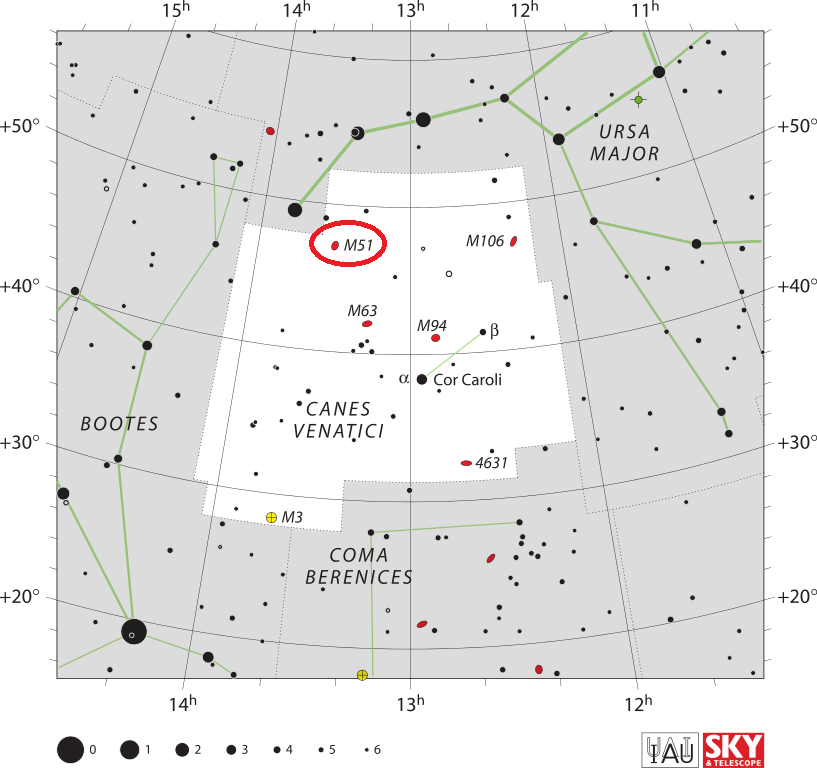
IMAGES
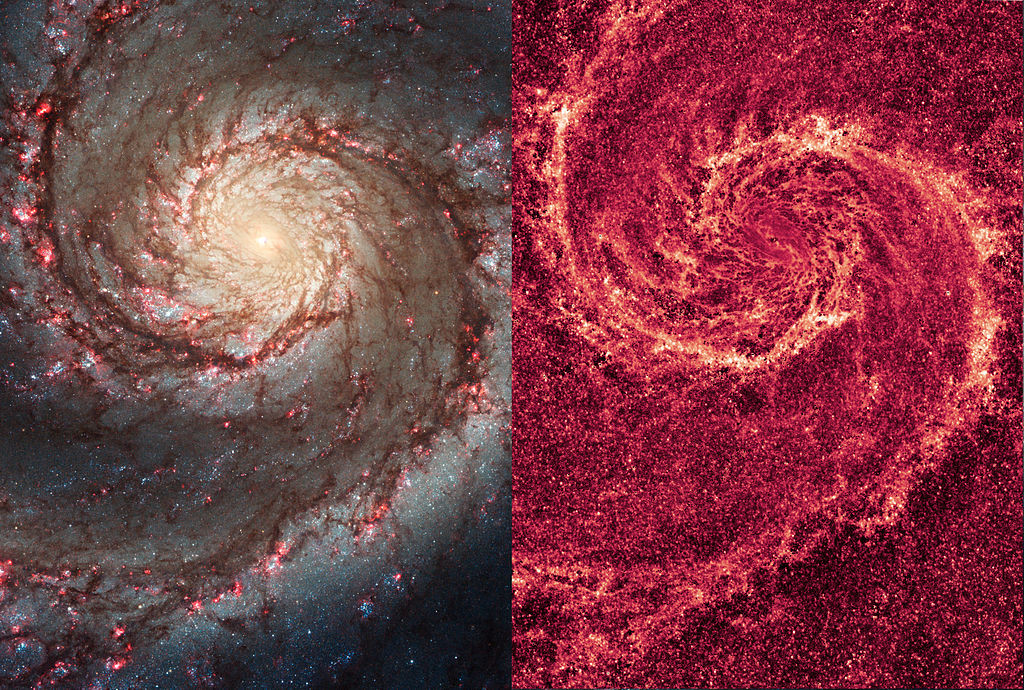
To map the galaxy’s dust structure, researchers collected the galaxy’s starlight by combining images taken in visible and near-infrared light. The visible-light image captured only some of the light; the rest was obscured by dust. The near-infrared view, however, revealed more starlight because near-infrared light penetrates dust. The researchers then subtracted the total amount of starlight from both images to see the galaxy’s dust structure. The red colour in the near-infrared image traces the dust, which is punctuated by hundreds of tiny clumps of stars, each about 65 light-years wide. These stars have never been seen before. The star clusters cannot be seen in visible light because dense dust enshrouds them. The image reveals details as small as 35 light-years across. Image – infrared: NASA, ESA, M. Regan & B. Whitmore (STScI), & R. Chandar (U. Toledo); Optical: NASA, ESA, S. Beckwith (STScI), & the Hubble Heritage Team (STScI/AURA)
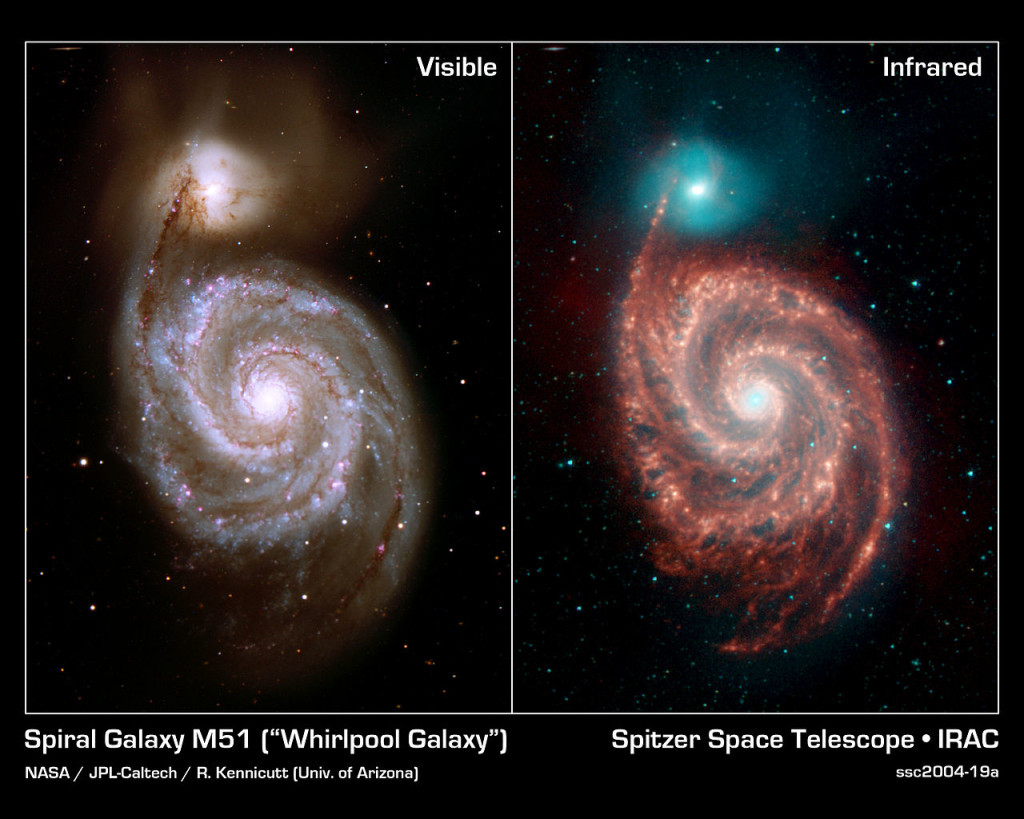
The light seen in the images originates from very different sources. At shorter wavelengths (in the visible bands, and in the infrared from 3.6 to 4.5 microns), the light comes mainly from stars. This starlight fades at longer wavelengths (5.8 to 8.0 microns), where we see the glow from clouds of interstellar dust. This dust consists mainly of a variety of carbon-based organic molecules known collectively as polycyclic aromatic hydrocarbons. Wherever these compounds are found, there will also be dust granules and gas, which provide a reservoir of raw materials for future star formation.
Particularly puzzling are the large number of thin filaments of red emission seen in the infrared data between the arms of the large spiral galaxy. In contrast to the beady nature of the dust emission seen in the arms themselves, these spoke-like features are thin and regular, and prevalent in the gaps all over the face of the galaxy.
Also of interest is the contrast in the distributions of dust and stars between the spiral and its faint companion. While the spiral is rich in dust, bright in the longer infrared wavebands, and actively forming new stars, its blue companion shows little infrared emission and hosts an older stellar population. The spectacular whirlpool structure and star formation in M51 are thought to be triggered by an ongoing collision with its companion. Understanding the impact on star formation by the interaction of galaxies is one of the goals of these observations.
The Spitzer observations of M51 are part of a large 500-hour science project, known as the Spitzer Infrared Nearby Galaxy Survey, which will comprehensively study 75 nearby galaxies with infrared imaging and spectroscopy. From these data, astronomers will probe the physical processes connecting star formation to the properties of galaxies. This information will provide a vital foundation of data, diagnostic tools, and astrophysical inputs for understanding the distant universe, ultraluminous galaxies, and the formation and evolution of galaxies. Image: NASA/JPL-Caltech/R. Kennicutt (Univ. of Arizona)/DSS
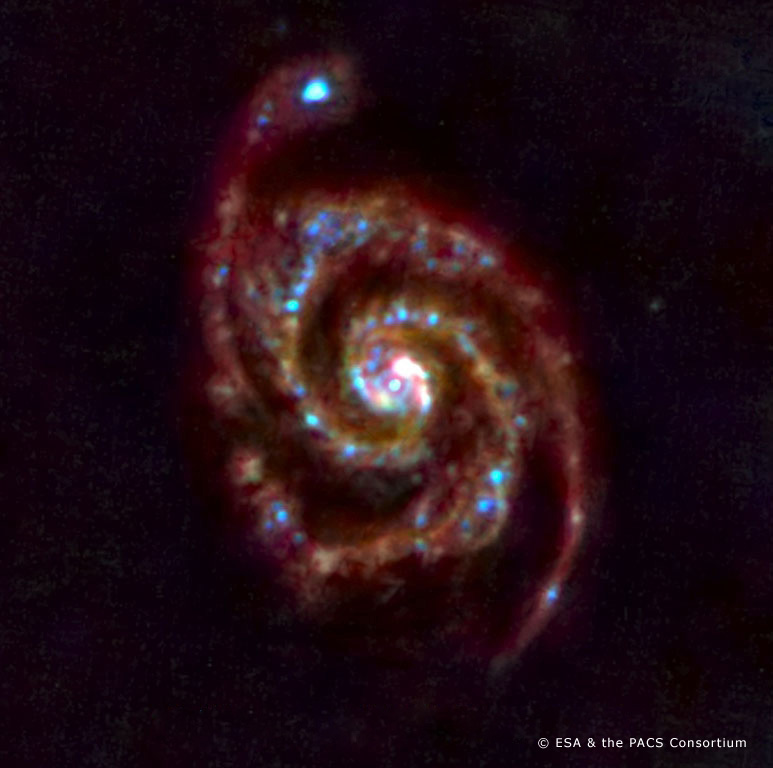
Red, green and blue correspond to the 160-micron, 100-micron and 70-micron wavelength bands of the HerschelÕs Photoconductor Array Camera and Spectrometer, PACS instruments. Glowing light from clouds of dust and gas around and between the stars is visible clearly. These clouds are a reservoir of raw material for ongoing star formation in this galaxy. Blue indicates regions of warm dust that is heated by young stars, while the colder dust shows up in red. Image: ESA and the PACS Consortium
